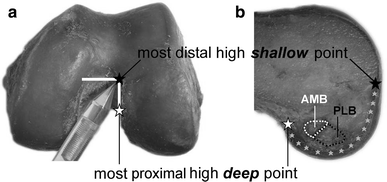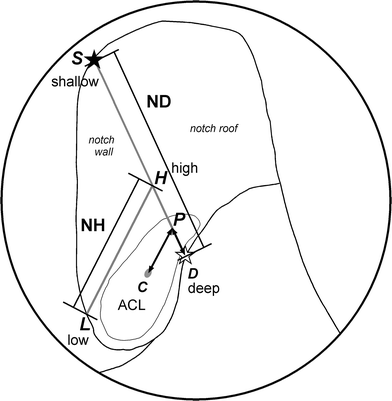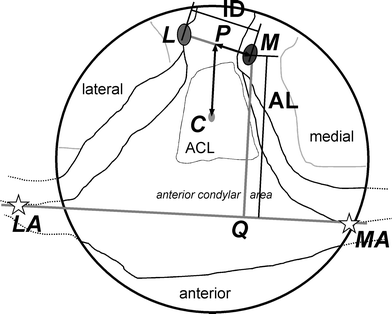Description of the attachment geometry of the anteromedial and posterolateral bundles of the ACL from arthroscopic perspective for anatomical tunnel placement
- PMID: 17899008
- PMCID: PMC2082657
- DOI: 10.1007/s00167-007-0402-0
Description of the attachment geometry of the anteromedial and posterolateral bundles of the ACL from arthroscopic perspective for anatomical tunnel placement
Abstract
The anterior cruciate ligament (ACL) consists of an anteromedial bundle (AMB) and a posterolateral bundle (PLB). A reconstruction restoring the functional two-bundled nature should be able to approximate normal ACL function better than the most commonly used single-bundle reconstructions. Accurate tunnel positioning is important, but difficult. The purpose of this study was to provide a geometric description of the centre of the attachments relative to arthroscopically visible landmarks. The AMB and PLB attachment sites in 35 dissected cadaver knees were measured with a 3D system, as were anatomical landmarks of femur and tibia. At the femur, the mean ACL centre is positioned 7.9 +/- 1.4 mm (mean +/- 1 SD) shallow, along the notch roof, from the most lateral over-the-top position at the posterior edge of the intercondylar notch and from that point 4.0 +/- 1.3 mm from the notch roof, low on the surface of the lateral condyle wall. The mean AMB centre is at 7.2 +/- 1.8 and 1.4 +/- 1.7 mm, and the mean PLB centre at 8.8 +/- 1.6 and 6.7 +/- 2.0 mm. At the tibia, the mean ACL centre is positioned 5.1 +/- 1.7 mm lateral of the medial tibial spine and from that point 9.8 +/- 2.1 mm anterior. The mean AMB centre is at 3.0 +/- 1.6 and 9.4 +/- 2.2 mm, and the mean PLB centre at 7.2 +/- 1.8 and 10.1 +/- 2.1 mm. The ACL attachment geometry is well defined relative to arthroscopically visible landmarks with respect to the AMB and PLB. With simple guidelines for the surgeon, the attachments centres can be found during arthroscopic single-bundle or double-bundle reconstructions.
Figures







Similar articles
-
[Anatomic and clinical study on 4-bone-tunnel double-bundle anterior cruciate ligament].Zhonghua Yi Xue Za Zhi. 2009 Aug 4;89(29):2019-24. Zhonghua Yi Xue Za Zhi. 2009. PMID: 20017321 Chinese.
-
Tibial insertions of the anteromedial and posterolateral bundles of the anterior cruciate ligament: morphometry, arthroscopic landmarks, and orientation model for bone tunnel placement.Arthroscopy. 2008 Feb;24(2):154-61. doi: 10.1016/j.arthro.2007.08.006. Epub 2007 Nov 8. Arthroscopy. 2008. PMID: 18237698
-
Double-bundle "anatomic" anterior cruciate ligament reconstruction: a cadaveric study of tunnel positioning with a transtibial technique.Arthroscopy. 2007 Jan;23(1):7-13. doi: 10.1016/j.arthro.2006.08.008. Arthroscopy. 2007. PMID: 17210421
-
Anatomy of the anterior cruciate ligament with regard to its two bundles.Clin Orthop Relat Res. 2007 Jan;454:35-47. doi: 10.1097/BLO.0b013e31802b4a59. Clin Orthop Relat Res. 2007. PMID: 17075382 Review.
-
The proximal posterior cartilage of the lateral femoral condyle can be used as a reference for positioning the femoral tunnel in ACL reconstruction.Knee Surg Sports Traumatol Arthrosc. 2023 Jun;31(6):2412-2417. doi: 10.1007/s00167-022-07168-z. Epub 2022 Oct 8. Knee Surg Sports Traumatol Arthrosc. 2023. PMID: 36208341 Review.
Cited by
-
The anterior cruciate ligament: a study on its bony and soft tissue anatomy using novel 3D CT technology.Knee Surg Sports Traumatol Arthrosc. 2017 Jan;25(1):236-244. doi: 10.1007/s00167-016-4310-z. Epub 2016 Sep 13. Knee Surg Sports Traumatol Arthrosc. 2017. PMID: 27624179
-
Evaluation of ACL mid-substance cross-sectional area for reconstructed autograft selection.Knee Surg Sports Traumatol Arthrosc. 2014 Jan;22(1):207-13. doi: 10.1007/s00167-012-2356-0. Epub 2012 Dec 22. Knee Surg Sports Traumatol Arthrosc. 2014. PMID: 23263230
-
The importance of Blumensaat's line morphology for accurate femoral ACL footprint evaluation using the quadrant method.Knee Surg Sports Traumatol Arthrosc. 2018 Feb;26(2):455-461. doi: 10.1007/s00167-017-4501-2. Epub 2017 Mar 10. Knee Surg Sports Traumatol Arthrosc. 2018. PMID: 28283721
-
The correlation of femoral tunnel length with the height and area of the lateral wall of the femoral intercondylar notch in anatomical single-bundle ACL reconstruction.Knee Surg Sports Traumatol Arthrosc. 2017 May;25(5):1632-1637. doi: 10.1007/s00167-016-4025-1. Epub 2016 Feb 4. Knee Surg Sports Traumatol Arthrosc. 2017. PMID: 26846660
-
Anterior cruciate ligament bundle insertions vary between ACL-rupture and non-injured knees.Knee Surg Sports Traumatol Arthrosc. 2021 Apr;29(4):1164-1172. doi: 10.1007/s00167-020-06122-1. Epub 2020 Jul 1. Knee Surg Sports Traumatol Arthrosc. 2021. PMID: 32613337
References
-
- {'text': '', 'ref_index': 1, 'ids': [{'type': 'DOI', 'value': '10.1007/s001670050041', 'is_inner': False, 'url': 'https://doi.org/10.1007/s001670050041'}, {'type': 'PubMed', 'value': '9335024', 'is_inner': True, 'url': 'https://pubmed.ncbi.nlm.nih.gov/9335024/'}]}
- Aglietti P, Buzzi R, Giron F, Simeone AJ, Zaccherotti G (1997) Arthroscopic-assisted anterior cruciate ligament reconstruction with the central third patellar tendon. A 5–8-year follow-up. Knee Surg Sports Traumatol Arthrosc 5(3):138–144 - PubMed
-
- {'text': '', 'ref_index': 1, 'ids': [{'type': 'DOI', 'value': '10.1007/BF01467913', 'is_inner': False, 'url': 'https://doi.org/10.1007/bf01467913'}, {'type': 'PubMed', 'value': '7584193', 'is_inner': True, 'url': 'https://pubmed.ncbi.nlm.nih.gov/7584193/'}]}
- Amis AA, Beynnon B, Blankevoort L, Chambat P, Christel P, Durselen L, Friederich N, Grood E, Hertel P, Jakob R (1994) Proceedings of the ESSKA Scientific Workshop on Reconstruction of the Anterior and Posterior Cruciate Ligaments. Knee Surg Sports Traumatol Arthrosc 2(3):124–132 - PubMed
-
- {'text': '', 'ref_index': 1, 'ids': [{'type': 'PubMed', 'value': '2005151', 'is_inner': True, 'url': 'https://pubmed.ncbi.nlm.nih.gov/2005151/'}]}
- Amis AA, Dawkins GP (1991) Functional anatomy of the anterior cruciate ligament. Fibre bundle actions related to ligament replacements and injuries. J Bone Joint Surg Br 73(2):260–267 - PubMed
-
- {'text': '', 'ref_index': 1, 'ids': [{'type': 'DOI', 'value': '10.1007/s001670050215', 'is_inner': False, 'url': 'https://doi.org/10.1007/s001670050215'}, {'type': 'PubMed', 'value': '9608456', 'is_inner': True, 'url': 'https://pubmed.ncbi.nlm.nih.gov/9608456/'}]}
- Amis AA, Jakob RP (1998) Anterior cruciate ligament graft positioning, tensioning and twisting. Knee Surg Sports Traumatol Arthrosc 6(Suppl 1):S2–S12 - PubMed
-
- {'text': '', 'ref_index': 1, 'ids': [{'type': 'PubMed', 'value': '6821989', 'is_inner': True, 'url': 'https://pubmed.ncbi.nlm.nih.gov/6821989/'}]}
- Arnoczky SP (1983) Anatomy of the anterior cruciate ligament. Clin Orthop 172:19–25 - PubMed
Publication types
MeSH terms
LinkOut - more resources
Full Text Sources

